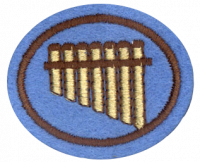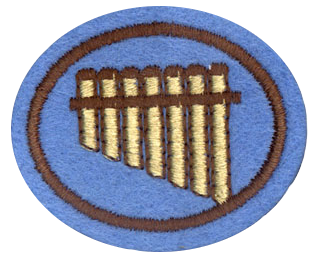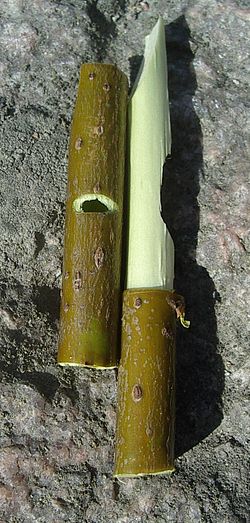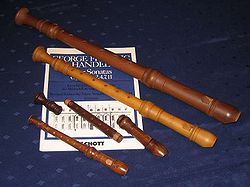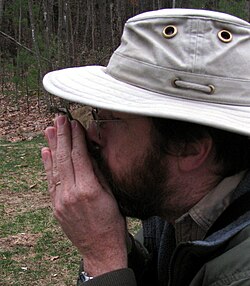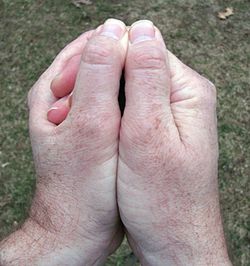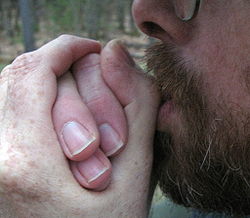Difference between revisions of "AY Honors/Whistles/Answer Key/es"
(Created page with "{{clear}}") |
(Created page with "</noinclude> <!-- 16. Saber cómo afilar una navaja utilizando una piedra húmeda para afilar o una piedra de aceite para afilar. -->") |
||
| Line 242: | Line 242: | ||
{{CloseReq}} <!-- 14 --> | {{CloseReq}} <!-- 14 --> | ||
{{ansreq|page={{#titleparts:{{PAGENAME}}|2|1}}|num=15}} | {{ansreq|page={{#titleparts:{{PAGENAME}}|2|1}}|num=15}} | ||
| − | <noinclude> | + | <noinclude></noinclude> |
| − | </noinclude> | + | <!-- 15. Revisar y demostrar primeros auxilios adecuados y normas de seguridad para el uso de una navaja de bolsillo. --> |
| − | <!-- 15. | + | {{:Adventist Youth Honors Answer Book/First aid/Bleeding/es}}<br /> |
| − | + | Para más información, véase la especialidad de [[AY Honors/First Aid, Basic/es|Primeros Auxilios]]. | |
| − | {{:Adventist Youth Honors Answer Book/First aid/Bleeding}}<br> | ||
| − | |||
| − | |||
| − | + | ===Seguridad con la navaja=== | |
| − | + | {{:Adventist Youth Honors Answer Book/Camping/Knife safety/es}} | |
| − | {{:Adventist Youth Honors Answer Book/Camping/Knife safety}} | ||
| − | |||
| − | + | <noinclude></noinclude> | |
| − | <noinclude | ||
| − | |||
{{CloseReq}} <!-- 15 --> | {{CloseReq}} <!-- 15 --> | ||
{{ansreq|page={{#titleparts:{{PAGENAME}}|2|1}}|num=16}} | {{ansreq|page={{#titleparts:{{PAGENAME}}|2|1}}|num=16}} | ||
| − | <noinclude> | + | <noinclude></noinclude> |
| − | </noinclude> | + | <!-- 16. Saber cómo afilar una navaja utilizando una piedra húmeda para afilar o una piedra de aceite para afilar. --> |
| − | <!-- 16. | ||
| − | |||
| − | + | {{clear}} | |
| − | |||
| − | |||
| − | + | {{clear}} | |
| − | |||
| − | |||
| − | + | <noinclude></noinclude> | |
| − | <noinclude | ||
| − | |||
{{CloseReq}} <!-- 16 --> | {{CloseReq}} <!-- 16 --> | ||
{{ansreq|page={{#titleparts:{{PAGENAME}}|2|1}}|num=17}} | {{ansreq|page={{#titleparts:{{PAGENAME}}|2|1}}|num=17}} | ||
| Line 284: | Line 269: | ||
</div></noinclude> | </div></noinclude> | ||
{{ansreq|page={{#titleparts:{{PAGENAME}}|2|1}}|num=17a}} | {{ansreq|page={{#titleparts:{{PAGENAME}}|2|1}}|num=17a}} | ||
| − | <noinclude> | + | <noinclude></noinclude> |
| − | </noinclude | ||
| − | |||
| − | |||
| − | + | {{clear}} | |
| − | |||
| − | |||
| − | + | {{clear}} | |
| − | { | ||
| − | |||
| − | |||
| − | |||
| − | |||
| − | |||
| − | |||
| − | |||
| − | |||
| − | |||
| − | |||
| − | |||
| − | |||
| − | |||
| − | |||
| − | |||
| − | |||
| − | |||
| − | |||
| − | |||
| − | |||
| − | |||
| − | |||
| − | |||
| − | |||
| − | + | {{clear}} | |
| − | |||
| − | |||
| − | + | {{clear}} | |
| − | |||
| − | |||
| − | + | {{clear}} | |
| − | |||
| − | |||
| − | + | <noinclude></noinclude> | |
| − | <noinclude | ||
| − | |||
{{CloseReq}} <!-- 17a --> | {{CloseReq}} <!-- 17a --> | ||
{{ansreq|page={{#titleparts:{{PAGENAME}}|2|1}}|num=17b}} <!--T:70--> | {{ansreq|page={{#titleparts:{{PAGENAME}}|2|1}}|num=17b}} <!--T:70--> | ||
| − | <noinclude> | + | <noinclude></noinclude> |
| − | </noinclude | ||
| − | |||
| − | |||
| − | + | {{clear}} | |
| − | |||
| − | |||
| − | + | {{clear}} | |
| − | |||
| − | |||
| − | + | {{clear}} | |
| − | { | ||
| − | |||
| − | |||
| − | |||
| − | |||
| − | |||
| − | |||
| − | |||
| − | |||
| − | |||
| − | |||
| − | |||
| − | |||
| − | |||
| − | |||
| − | |||
| − | |||
| − | |||
| − | |||
| − | |||
| − | |||
| − | |||
| − | |||
| − | |||
| − | |||
| − | + | {{clear}} | |
| − | |||
| − | |||
| − | + | <noinclude></noinclude> | |
| − | <noinclude | ||
| − | |||
{{CloseReq}} <!-- 17b --> | {{CloseReq}} <!-- 17b --> | ||
{{CloseReq}} <!-- 17 --> | {{CloseReq}} <!-- 17 --> | ||
| Line 393: | Line 304: | ||
</div> | </div> | ||
| − | + | {{clear}} | |
| − | |||
| − | { | ||
| − | |||
| − | |||
| − | |||
| − | |||
| − | |||
| − | |||
| − | |||
| − | |||
| − | |||
| − | |||
| − | |||
| − | |||
| − | |||
| − | |||
| − | |||
| − | |||
| − | |||
| − | |||
| − | |||
| − | |||
| − | |||
| − | { | ||
| − | |||
| − | |||
| − | |||
| − | |||
| − | |||
| − | |||
| − | |||
| − | |||
| − | |||
| − | |||
| − | |||
| − | |||
| − | |||
| − | |||
| − | |||
| − | + | <noinclude></noinclude> | |
| − | <noinclude | ||
| − | |||
{{CloseReq}} <!-- 18 --> | {{CloseReq}} <!-- 18 --> | ||
| − | <noinclude> | + | <noinclude></noinclude> |
| − | </noinclude> | + | ==Referencias== |
| − | == | + | [[Category:Adventist Youth Honors Answer Book/es]] |
| − | + | <noinclude></noinclude> | |
| − | [[Category:Adventist Youth Honors Answer Book | ||
| − | <noinclude | ||
| − | |||
{{CloseHonorPage}} | {{CloseHonorPage}} | ||
Revision as of 13:40, 4 May 2021
1
2
3
Sap is a liquid that circulates within the sapwood of trees. Sap rises up from the roots. Sap contains water and minerals; in the spring it also contains sugars and stimulates the growth of the tree.
4
Willow and Maple trees (especially striped maple, Acer pensylvanicum) are considered the best for making whistles. Willow is often more plentiful than maple, and they grow back very quickly when cut. Some prefer maple because it is straighter and has fewer knots. Maples also grow back quickly if cut from a large stump.
Other trees that can be used for whistle-making include:
- Alder, aspen, and poplar
- These species can also be used for making slip-bark whistles. As with any slip-bark whistle though, they should be made in the spring or early summer when the sap is up. After that, it's too difficult to slip the bark off the wood.
- Elderberry
- Elderberry has a pithy core that can be easily removed. In this case, the bark is not used as the outer sheath, but rather, the whole twig is. You must find another piece of wood to fit tightly into the pith and shave off the top edge of it to make the whistle.
- Sumac
- If you select a sumac tree, make sure it is not a poison sumac tree (Rhus vernix). All parts of the poison sumac contain the same resin as poison ivy and can cause a person to suffer from an itchy rash. Poison sumac has white berries. If the sumac has red berries, it is OK to use and will not cause a rash.
5
5a
5b
5c
6
- Pea Whistle
- Pea whistles are used by referees in many sports. It is a whistle with a small ball trapped inside which makes a rattling sound as the whistle resonates.
- Transverse Flutes
- Transverse flutes are a form of whistle used in modern orchestras. They are operated by blowing across a hole located on the mouthpiece.
- Tin Whistle
- This is another form of musical whistle, but unlike the transverse flute, it is end-blown and has only six holes. It is an important instrument in Irish folk songs.
- Dog Whistes
- Dog whistles are used for training dogs or for commanding them from a distance. Some of these are too high to be heard by humans, but dogs can hear them (and respond) just fine.
- Slide Whistle
- A slide whistle is a whistle whose pitch can be varied by moving a slide. These are often considered novelty items (because of their use in cartoon sound effects), but also make an appearance in serious works of music in many cultures.
7
8
The whistle works by causing the smooth flow of air to be split by a narrow blade, sometimes called a fipple, creating a turbulent vortex which causes the air to vibrate. By attaching a resonant chamber to the basic whistle, it may be tuned to a particular note and made louder. The length of the chamber typically defines the resonance frequency.
9
In making a willow whistle, all that is needed is a sharp knife. A saw is handy too for cutting the branch from the tree, but this can be done with a knife too (just not as effectively).
10
For a slip-bark whistle, straight grain is important because it is easier to remove the bark intact from a piece of wood with straight grain. Grain becomes non-straight anywhere a branch grows a sub-branch. The bark will snag on these irregularities, making it difficult, if not impossible to remove.
11
A whistle makes a tone as the chamber alternately fills with air and evacuates that air. This cycle repeats several hundred times per second, and the more times per second it repeats, the higher the pitch. There are three main factors that affect how often this cycle repeats: the length of the chamber, the size of the opening(s), and the speed of sound. The speed of sound is (for all intents and purposes) fixed. If the ratio of these other two factors get too "out of whack" with one another, the flute will no longer make a tone. If the chamber is too long, the flute will never resonate. Instead, the air will simply flow through from one end to the other without setting up the fill/exhaust cycles. If the chamber is too wide, it will not be able to confine the air to make it resonate, and the flute will whisper. &
12
A whistle is tuned by changing the volume of the resonant chamber. This is primarily done by altering the length of the chamber, but altering the diameter will also have an effect.
13
Select a long, wide blade of grass. Prepare to hold your hands together as if to pray, with the lower portion of the thumbs touching one another, palms together, and with the tips of the thumbs touching. Lay the grass blade between the lower thumbs as you press them together. The upper portion of the blade will lie parallel to the thumbs and be pinched together by the thumb tips. Before pinching the upper portion of the blade, bend the thumbs slightly. Then pinch the grass blade between the tips of the thumbs (or the index fingers), and extend the thumbs (or index finger), pulling the grass taut.
14
Hold the fingers of the right hand together and bring the tips into a tight circle. Place them in the web between your left thumb and index finger, enclosing the left hand about the right. The two thumbs should be parallel to one another and resting on the right index finger. This should form a cavity with a small gap opening into it between the upper and lower thumb knuckles. Bend the thumbs slightly and place your lower lip just below the top joint in the thumbs. Place the upper lip on the top joint and blow downwards into the cavity. If you're doing it right, it will make a whistling noise very similar to the call of mourning dove or a bob white. Try to keep the cavity air tight except where your breath enters between the thumbs. Once you are able to do this, try raising the pinky of your left hand while whistling. The pitch should rise. Quickly raising and lowering the pinky repeatedly will cause the whistle to quaver. Try not to drive anyone crazy with your new-found skill!
15
Adventist Youth Honors Answer Book/First aid/Bleeding/es
Para más información, véase la especialidad de Primeros Auxilios.
Adventist Youth Honors Answer Book/Camping/Knife safety/es
16
17
17a
17b
18
If you are not musically inclined, an easy tune to learn is Hot Cross Buns. It consists of only three notes (C, D, and E), so the whistle does not need to span an entire octave. Indeed, any three notes that are separated by a whole step will do, so the whistle doesn't even need to be tuned to C, D, and E. It could also be F, G, A, or G, A, B, or any combination using flats or sharps as long as each note is a whole step from the previous one.
